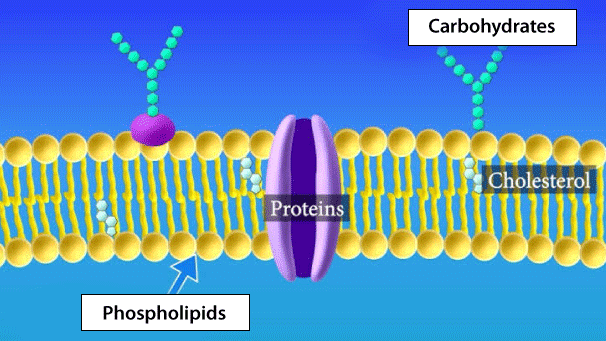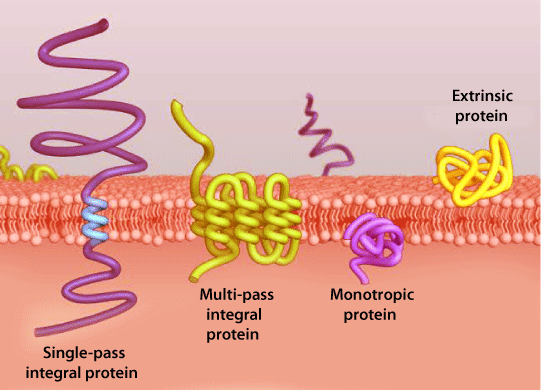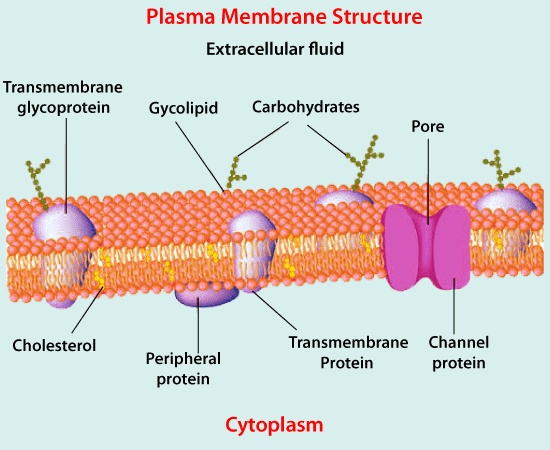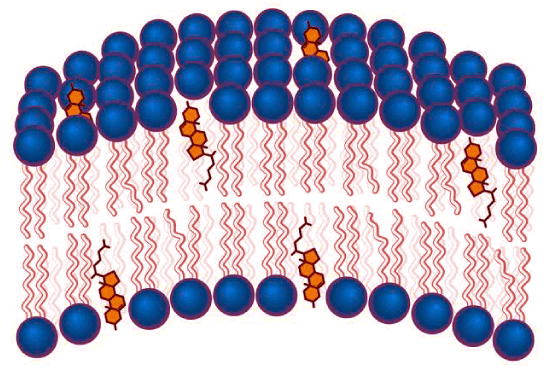List of the Constituents of Plasma MembraneThe Plasma membrane, which is also known as Cell Membrane, demarcates between the outer part and inner part of the cell, and it is a membrane found in all living beings' cells. The structure and components' division of Plasma Membrane is different for plant cells and animal cells, and a point to be noted here is that the structure and components of Plasma Membrane are different for different types of animal cells as well. In the exterior parts of plant cells, one can find a cell wall before the Plasma Membrane if talked about plant cells. And, Lipid molecules are observed before the Plasma Membrane if talking about the Bacterial Cell's Case. This layer of lipid molecules is also observed before the Plasma Membrane in many other animal cells, and it is a semipermeable layer. This layer is very important from the view of the Plasma Membrane as it is responsible for the transportation as well as regulations of materials inside the Plasma Membrane. Other than this, Plasma Membrane is also very important as it controls the in and out movement of the molecules inside a living cell, both large and small cells. All these materials found in Plasma Membrane made it composed of different types of constituents. This article talks about all general constituents of Plasma Membrane but before understanding all these constituents, let's have a look at the Fluid Mosaic Model of Plasma Membrane. Fluid Mosaic ModelA new model of the plasma membrane was suggested by S.J. Singer and Garth L. Nicolson in the year 1972, which explained the plasma membrane's functions and microscopic examinations in a much better way than the previously proposed theories, and this theory is named the "fluid mosaic model ". With time, the model has evolved a little bit, and even so, it best describes the functions and structure of the plasma membrane as one now understands them. According to the fluid mosaic model, the plasma membrane is constituted of multiple components, such as phospholipids, proteins, carbohydrates, and cholesterol, which flow and change the site whilst keeping up the membrane's elementary integrity. Embedded proteins and phospholipid molecules move sideward to the membrane, and the fluidity of the plasma membrane is essential for the transport of the molecules and actions of the enzymes inside the cell. Plasma membrane thickness is about 5- 10 nm. Human red blood cells, viewable through light microscopy, are nearly 8?m thick, or roughly 1,000 times thicker in comparison with a plasma membrane. The components of plasma membranes are as follows: (1) Phospholipid
The bilayer of phospholipid molecules composes the major stuff of the plasma membrane, and the polar ends of phospholipid (that look similar to a cluster of the balls in an interpretation model of an artisan) are in an association with watery fluid both in and out of the cell. As a consequence, both the planes of the plasma membrane are hydrophilic (water-loving) but in contrast, on the inside of the membrane, in the midst of its two planes, is a hydrophobic (water-fearing) or a non-polar section due to the fatty acid tails, this section or region do not have any attraction for polar molecules or water. A particle of phospholipid is comprised of the backbone of three-carbon glycerol in the company of two fatty acid particles bound to 1 and 2 carbons and a group that possesses phosphate attached to carbon 3. Such an organization provides the entire molecule with an area illustrated as its head (a group that contains phosphate), that possesses a negative charge or a polar nature, and a portion called a tail with no charge (the fatty acids). The tail cannot form hydrogen bonds, but the head can make hydrogen bonding. (2) Proteins
The second main chemical constituent of the plasma membrane is protein. Integral proteins are encapsulated in the plasma membrane and might stretch a part or all of the membrane and act as pumps or channels that help in the movement of particles inside and outside of the cell. Peripheral proteins are present on the internal areas or exterior of the plasma membrane, attached to either phospholipid molecules or to integral proteins. Integral and peripheral proteins both acts as enzymes, as constructural bonds for cytoskeleton fires, or as a component of recognition sites of the cell. Receptors are the recognized sites on the membrane that are sites for attachments for materials that collaborate with the cell, and each receptor is formed to attach to a particular material. The attachment of a particular material to its receptor on the plasma membrane accelerates activities inside the cell, like stimulating enzymes engaged in metabolic pathways. These metabolic pathways are important for giving energy to the cell, preparing substances for the cell or toxins for discarding or breakdown of the cell's waste. In addition, neurotransmitters and extracellular hormones attach to receptors of the plasma membrane that transfer a signal into the cells to molecules inside the cell. Viruses use some recognition sites as attachment points. Howbeit they are largely specified, disease-causing organisms like the virus may emerge to misuse the recognition sites to enter inside the cell by imitating the particular substance that is meant to be bound with the receptor. This particularity aids in the explanation of why HIV (Human Immunodeficiency Virus) or the hepatitis virus conquers only particular cells. (3) Carbohydrates
The third major constituent of the plasma membrane is always present on the cell's external surface, and it is attached either to lipids (making glycolipids) or proteins (making glycoproteins). About 2-60 monosaccharide units are composed of carbohydrate chains and can be branched or straight by structure. Carbohydrates with peripheral proteins create specialized sites on the surface of the cell that permits cells to identify one and all. These sites possess distinctive patterns which permit the cell to be identified, the same way facial features distinct to every individual let them be identified. This identification is essential for cells as it lets the immune system distinguish between foreign tissues or cells (known as non-self) and the body's cell (Known as self). The same types of glycolipids and glycoproteins are present on the superficial of viruses that change consistently, protecting immune cells from recognition and invading them. (4) Cholesterol
Cholesterol is an additional component of the plasma membrane found in the animal cell that aids in keeping up the membrane's fluidity. It lies apace with phospholipid in the plasma membrane, that moist the impact of temperature on the membrane. Hence, these lipids act as a cushion, preventing lower temperatures from hindering fluidity and averting high temperatures from elevating fluidity excessively. So, cholesterol enlarges in both ways, the range of temperature in that the membrane is adequately fluid and subsequently functioning. Cholesterol is also involved in some other functions, like arranging collections of transmembrane proteins lipid rafts, also known as microdomains. Membrane FluidityThe membrane's mosaic quality, stated in the fluid mosaic model, aids in illustrating its nature. Just like boats floating on a river, the proteins and other constituents present in the membrane can move with regard to one and all. The membrane isn't like a balloon but can enlarge and contract somewhat; it is firm and can burst if perforated or the cell intakes too much fluid inside. Although, due to its mosaic nature, a very thin needle can smoothly be pricked in a membrane without bursting it, and the membrane will flow and seal itself after the needle is removed. The mosaic qualities of the membrane describe few but not all of its fluidness, and there are two causes that aid in maintaining this fluid nature. The first factor is the characteristic of the phospholipid themselves, where the formation of the fatty acid tails in each phospholipid makes the membrane firmer and thicker or lesser it's thickness and flexibility. The membrane's relative fluidness is specifically more crucial in a cold environment, where the coldness tends to make the membrane less watery and more allowing it to rupture. Many organisms, like fishes, are able to adapt to cold environments by making a difference in the number of various types of fatty acids in their membrane in reaction to the decreasing temperature.
Next TopicList of AIIMS in India
|
 For Videos Join Our Youtube Channel: Join Now
For Videos Join Our Youtube Channel: Join Now
Feedback
- Send your Feedback to [email protected]
Help Others, Please Share









